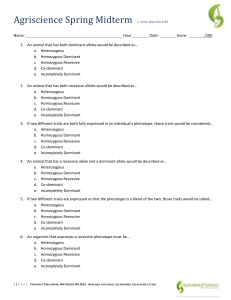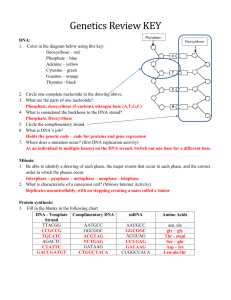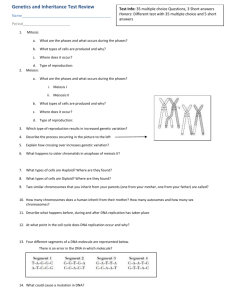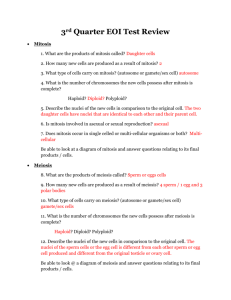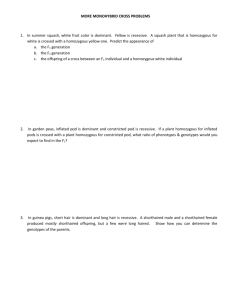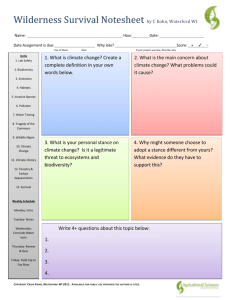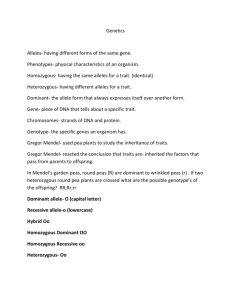Agriscience Practice Exam
advertisement
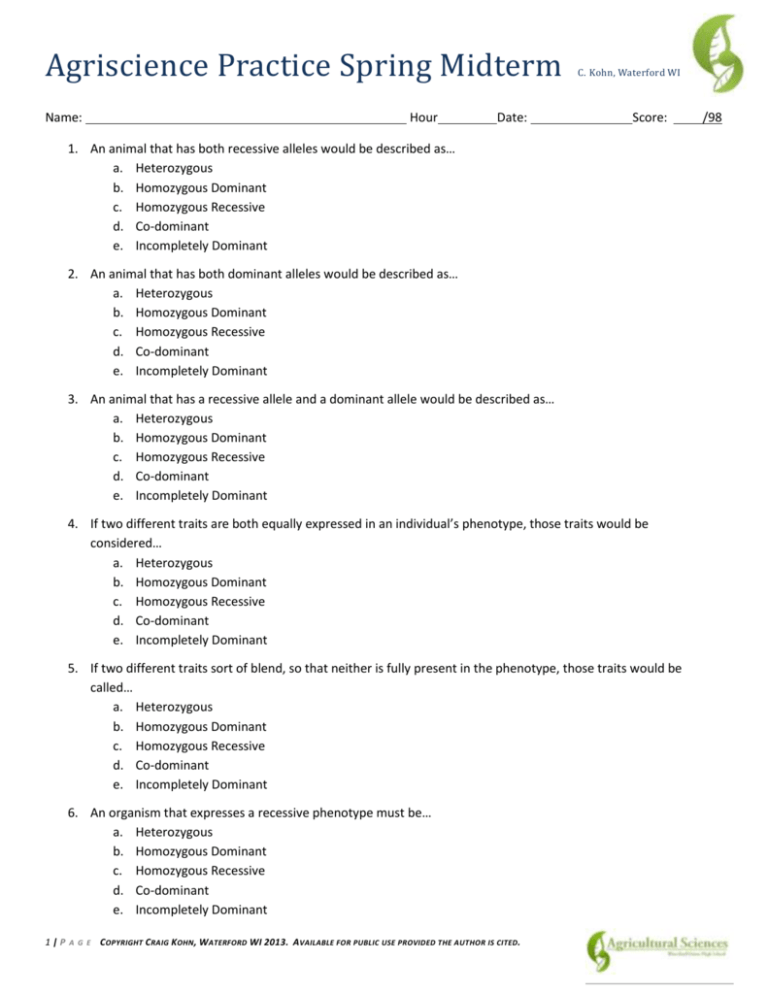
Agriscience Practice Spring Midterm Name: Hour Date: C. Kohn, Waterford WI Score: 1. An animal that has both recessive alleles would be described as… a. Heterozygous b. Homozygous Dominant c. Homozygous Recessive d. Co-dominant e. Incompletely Dominant 2. An animal that has both dominant alleles would be described as… a. Heterozygous b. Homozygous Dominant c. Homozygous Recessive d. Co-dominant e. Incompletely Dominant 3. An animal that has a recessive allele and a dominant allele would be described as… a. Heterozygous b. Homozygous Dominant c. Homozygous Recessive d. Co-dominant e. Incompletely Dominant 4. If two different traits are both equally expressed in an individual’s phenotype, those traits would be considered… a. Heterozygous b. Homozygous Dominant c. Homozygous Recessive d. Co-dominant e. Incompletely Dominant 5. If two different traits sort of blend, so that neither is fully present in the phenotype, those traits would be called… a. Heterozygous b. Homozygous Dominant c. Homozygous Recessive d. Co-dominant e. Incompletely Dominant 6. An organism that expresses a recessive phenotype must be… a. Heterozygous b. Homozygous Dominant c. Homozygous Recessive d. Co-dominant e. Incompletely Dominant 1 | P A G E C OPYRIGHT C RAIG K OHN , W ATERFORD WI 2013. A VAILABLE FOR PUBLIC USE PROVIDED THE AUTHOR IS CITED . /98 7. Epistasis is... a. The physical appearance of an organism that is the result of its genes. b. The combination of genes in an organism. c. When one gene affects the expression of another gene. d. The term for a version of a gene 8. A genotype is… a. The physical appearance of an organism that is the result of its genes. b. The combination of genes in an organism. c. When one gene affects the expression of another gene. d. The term for a version of a gene 9. An allele is… a. The physical appearance of an organism that is the result of its genes. b. The combination of genes in an organism. c. When one gene affects the expression of another gene. d. The term for a version of a gene 10. A phenotype is… a. The physical appearance of an organism that is the result of its genes. b. The combination of genes in an organism. c. When one gene affects the expression of another gene. d. The term for a version of a gene 11. If all of the offspring of a couple are the recessive phenotype, the parents must have which genotype combination? a. AA x AA b. Aa x Aa c. Aa x aa d. aa x aa 12. If 3/4s of the offspring have the dominant phenotype and ¼ have the recessive phenotype, the parent combination is most likely… a. AA x AA b. Aa x Aa c. Aa x aa d. aa x aa 13. If the offspring are half dominant, half recessive phenotypes, the parent combination is most likely… a. AA x AA b. Aa x Aa c. Aa x aa d. aa x aa 14. If all of the offspring are homozygous dominant, the parent combination must be… a. AA x AA b. Aa x Aa c. Aa x aa d. aa x aa 15. In Holstein cows, black is dominant and red is recessive. A bull and a cow (both heterozygous for color) have 3 calves. All of them are black. What are the odds that their fourth calf will be red? a. 0% b. 25% c. 50% d. 100% 16. The color Roan is an example of… a. Co-Dominance b. Incomplete Dominance c. Epistasis d. Recessive Alleles 2 | P A G E C OPYRIGHT C RAIG K OHN , W ATERFORD WI 2013. A VAILABLE FOR PUBLIC USE PROVIDED THE AUTHOR IS CITED . A bull, Foster, escapes from a farm and impregnates several cows. The offspring of the cows are all born the same day and get mixed up. On top of this, a calf bought at an auction gets mixed in with the new calves. Foster (red) Mr. Kohn is called to sort out the mess. However, his trusty Corolla breaks down on the way and he calls you to take his place. As he is explaining this to you over the phone, the low-battery warning goes off. The last thing you hear before his phone dies is… “red is recessive, and horns are recessive” There is only one combination of cows and calves that will work given this piece of knowledge. Show your work below! Berry Cherry Darlene 17. Who is Berry’s calf (show work below)? a. Unos b. Diane c. Tracy d. Quincy Tracy 18. Who is Cherry’s calf (show work below)? a. Unos b. Diane c. Tracy d. Quincy 19. Who is Darlene’s calf (show work below)? a. Unos b. Diane c. Tracy d. Quincy Diane Unos Quincy 20. Which calf was bought at an auction (Hint: which calf could not have come from any of the three combinations of Foster the Bull and one of the three cows?) a. Unos b. Diane c. Tracy d. Quincy 3 | P A G E C OPYRIGHT C RAIG K OHN , W ATERFORD WI 2013. A VAILABLE FOR PUBLIC USE PROVIDED THE AUTHOR IS CITED . A pair of frogs and their offspring are shown to the side. Couples are denoted with the dotted boxes around them. Offspring (Couples 1-4) are below the couples (the offspring of the top pair are connected to them with a line; their mates are unrelated to the top pair of frogs). Top Pair Above each frog, write their genotype. Then answer the questions below. You will be able to determine the genotype for each frog based on the parents and the offspring. The questions below involve all the frogs shown. Couple 1 Couple 2 21. How many frogs on this page are homozygous recessive? a. 1 b. 2 c. 11 d. 13 e. 15 22. How many frogs were homozygous dominant? a. 1 b. 2 c. 11 d. 13 e. 15 23. How many frogs were heterozygous? a. 1 b. 2 c. 11 d. 13 e. 15 24. What are the genotypes of Couple 1? a. Gg x Gg b. GG x gg c. Gg x gg d. gg x gg e. GG x GG 25. What are the genotypes of Couple 2? a. Gg x Gg b. GG x gg c. Gg x gg d. gg x gg e. GG x GG 26. What are the genotypes of Couple 3? a. Gg x Gg b. GG x gg c. Gg x gg d. gg x gg e. GG x GG 27. What are the genotypes of Couple 4? a. Gg x Gg b. GG x gg c. Gg x gg d. gg x gg e. GG x GG 4 | P A G E C OPYRIGHT C RAIG K OHN , W ATERFORD WI 2013. A VAILABLE FOR PUBLIC USE PROVIDED THE AUTHOR IS CITED . Couple 3 Couple 4 A farmer selects two goats to mate. The farmer wants to raise curly-horned goats. The first goat is polled (no horns). The other goat has curly horns. Polled is dominant to horns and straight horns are dominant to curly. They have the following genotypes: Goat 1: PpHh Goat 2: pphh PP, Pp = polled; pp = horned HH, Hh = straight horns; hh= curly horns Polled = P _ _ _ Horned = pp _ _ Straight horns = ppHh or ppHH Curled horns = pphh Complete the dihybrid Punnett Square before continuing 28. Complete the Punnett square to the right 29. What are the odds that any given goat baby will be polled? a. 16/16 b. 8/16 c. 6/16 d. 4/16 e. 2/16 30. What are the odds that any given baby will be straight horned? a. 16/16 b. 8/16 c. 6/16 d. 4/16 e. 2/16 31. What are the odds that any given baby will be curly horned? a. 16/16 b. 8/16 c. 6/16 d. 4/16 e. 2/16 32. Could two polled goats have a horned baby? a. Yes b. No 33. Could two horned goats have a polled baby? a. Yes b. No 34. DNA encodes the instructions to create a/an… a. Amino acid b. Protein c. Sugar molecule d. Cell membrane 5 | P A G E C OPYRIGHT C RAIG K OHN , W ATERFORD WI 2013. A VAILABLE FOR PUBLIC USE PROVIDED THE AUTHOR IS CITED . 35. A gene is… a. A tightly-wound package of DNA b. A section of DNA that codes for a specific protein c. A visible trait d. All of the above 36. In the picture at the right, this is I a. Phosphate b. Nitrogenous Base c. Deoxyribose sugar d. Nucleotide 37. In the picture at the right, this is II a. Phosphate b. Nitrogenous Base c. Deoxyribose sugar d. Nucleotide IV I II III 38. In the picture at the right, this is III a. Phosphate b. Nitrogenous Base c. Deoxyribose sugar d. Nucleotide 39. In the picture at the right, this is IV a. Phosphate b. Nitrogenous Base c. Deoxyribose sugar d. Nucleotide 40. This item in the picture could represent Adenine, Cytosine, Thymine, or Guanine a. I b. II c. III d. IV 41. This structure contains the 5’ and 3’ carbons that give DNA its sense of direction a. I b. II c. III d. IV 42. Which of the following accurately indicates the correct pairing of bases? a. A – C; G – T b. A – G; C – T c. G – C; T – A d. G – G; C – C; A - T 43. Specific combinations of bases exist because… a. They can’t fit in any other combination b. They can’t bond in any other combination c. Both A and B d. None of the above are correct 44. Which has 3 bonding sites? a. Adenine & Thymine b. Cytosine & Guanine c. Adenine & Guanine d. Cytosine & Thymine 6 | P A G E C OPYRIGHT C RAIG K OHN , W ATERFORD WI 2013. A VAILABLE FOR PUBLIC USE PROVIDED THE AUTHOR IS CITED . 45. 46. 47. 48. 49. 50. 51. 52. Use the picture at the right for the following questions. This structure is DNA A. B. C. D. This structure is mRNA A. B. C. A D. This structure is the ribosome A. B. C. D. This structure is tRNA A. B. C. D. This structure is created by polymerase A. B. C. D. This structure is opened by helicase A. B. C. D. This structure delivers amino acids A. B. C. D. C This structure reads copies of DNA and creates proteins A. B. C. D. 53. How does RNA differ from DNA? a. The G’s in DNA become U’s in RNA b. DNA is double stranded; RNA can be single stranded c. RNA has an extra –OH molecule d. All of the above are correct D B 54. A codon is a…. a. String of amino acids b. A kind of amino acid c. The structure that reads mRNA and makes a protein d. A group of three nucleotide bases 55. B Which would be the correct mRNA version of this strand of DNA? 3' CCC-GTA-ATG-GCA-TAA-ATC 5' a. b. c. d. 3’ CCC – GTA – ATG – GCA - TAA - ATC 5’ 5’ CCC – GTA – ATG – GCA – TAA - ATC 3’ 3’ GGG – CAU – UAC – CGU – AUU - UAG 5’ 5’ GGG – CAU – UAC – CGU – AUU - UAG 3’ 56. What is the correct amino acid sequence for the mRNA above? a. Gly – His – Tyr – Arg – Ile – Term b. Term – Ile – Arg – Tyr – His – Gly c. Ile – Leu – Cys – His – Tyr – Gly d. Ala – Asp – Glu – Gly – Phe – Leu 7 | P A G E C OPYRIGHT C RAIG K OHN , W ATERFORD WI 2013. A VAILABLE FOR PUBLIC USE PROVIDED THE AUTHOR IS CITED . 57. Transcription is the process in which… a. A protein is made from amino acids based on what was copied by mRNA b. The strand of DNA leaves the nucleus and becomes the amino acids that create a protein c. A strand of mRNA is copied from DNA by polymerase d. Helicase creates a protein out of amino acids 58. Translation is the process in which… a. A protein is made from amino acids based on what was copied by mRNA b. The strand of DNA leaves the nucleus and becomes the amino acids that create a protein c. A strand of mRNA is copied from DNA by polymerase d. Helicase creates a protein out of amino acids 59. Transcription occurs in the… a. Ribosome b. Mitochondria c. Chloroplast d. Nucleus 60. Translation occurs in the… a. Ribosome b. Mitochondria c. Chloroplast d. Nucleus 61. These are a part of transcription: a. DNA and mRNA b. DNA and a ribosome c. mRNA, tRNA, and a ribosome d. All of the above 62. These are a part of translation: a. DNA and mRNA b. DNA and a ribosome c. mRNA, tRNA, and a ribosome d. All of the above 63. If an organism’s tRNA were to become dysfunctional, which of the following would most likely occur? a. They wouldn’t be able to create a mRNA copy of DNA b. The ribosome would not be able to read mRNA c. Amino acids could not be delivered to the ribosome to make a protein d. All of the above 64. Which of the following amino acids forms a special bond called a disulfide bond, a bond which causes it to bind to other amino acids that are the same kind as itself? a. Glutamine b. Tyrosine c. Serine d. Cysteine 65. The shape of a protein determines its… a. Amino acid sequence b. Function c. Lifespan d. Location 66. Hydrophilic amino acids will always move to the a. Inside b. Outside c. Top d. Bottom of a protein 8 | P A G E C OPYRIGHT C RAIG K OHN , W ATERFORD WI 2013. A VAILABLE FOR PUBLIC USE PROVIDED THE AUTHOR IS CITED . 67. Hydrophobic amino acids will always move to the a. Inside b. Outside c. Top d. Bottom of a protein 68. Oppositely charged amino acids will always… a. Bond with each other b. Repel each other c. Move to the inside d. Move to the bottom 69. Similarly charged amino acids will always… a. Bond with each other b. Repel each other c. Move to the inside d. Move to the bottom 70. The primary structure of an amino acid refers to… a. The overall structure of the protein b. The combination of alpha helixes and beta sheets c. The order of amino acids d. The formation of an alpha helix or a beta sheet 71. The tertiary structure of an amino acid refers to… a. The overall structure of the protein b. The combination of alpha helixes and beta sheets c. The order of amino acids d. The formation of an alpha helix or a beta sheet 72. A frameshift mutation is one that… a. Causes a deletion b. Causes an insertion c. Causes all of the bases downstream to shift d. Causes no change to the protein structure 73. A frameshift mutation will change the of a protein a. Shape b. Function c. Secondary and Tertiary structure d. All of the above 74. Which of the following is shown in X to the right? a. Alpha Helix b. Beta Sheet c. Amino Acid d. Polypeptide 75. Which of the following is shown in Y to the right? a. Alpha Helix b. Beta Sheet c. Amino Acid d. Polypeptide 76. X and Y together would make which of the following? a. Alpha Helix b. Beta Sheet c. Amino Acid d. Polypeptide 9 | P A G E C OPYRIGHT C RAIG K OHN , W ATERFORD WI 2013. A VAILABLE FOR PUBLIC USE PROVIDED THE AUTHOR IS CITED . 77. Which of the following would be the correct transcribed mRNA molecule for the DNA sequence below? . 3’ a. b. c. d. TAC-TTA-CGA-TGG-TAC-ACG-TGT-ACC-TTG-AAC-CTG-ACT 5’ 5’ – ATG-AAT-GCT-ACC-ATG-TGC-ACA-TGG-AAC-TTG-GAC-TGA- 3’ 5’ – AUG-AAU-GCU-ACC-AUG-UGC-ACA-UGG-AAC-UUG-GAC-UGA- 3’ 3’ – ATG-AAT-GCT-ACC-ATG-TGC-ACA-TGG-AAC-TTG-GAC-TGA- 5’ 3’ – AUG-AAU-GCU-ACC-AUG-UGC-ACA-UGG-AAC-UUG-GAC-UGA- 5’ 78. Which of the following would be the correct order of translated amino acids from the mRNA strand above? a. Met – Asn – Ala – Thr – Met – Cys – Thr – Trp – Asn – Leu – Asp b. Ser – Gln – Val – Gln – Gly – Thr – Arg – Val – Pro – Ser- Term c. Asn – Ala – Thr – Met – Trp – Pro – Arg – Val – Met – Asp – Trp d. Ile – Phe – Ser – Cys – His – Arg – Val – Ala – Asp – Glu – Leu - Term 10 | P A G E C OPYRIGHT C RAIG K OHN, W ATERFORD WI 2013. A VAILABLE FOR PUBLIC USE PROVIDED THE AUTHOR IS CITED . 79. How many chromosomes do humans have in their cells? a. 46 – 23 from their father and 23 from their mother b. 23 – all from their mother c. 23 – all from their father d. 23 – either from their mother or from their father (it’s up to chance) 80. Chromosomes are… a. Bundles of DNA b. Proteins c. The nucleus of the cell d. All of the above 81. What was the contribution of Darwin to modern genetics? a. He showed how patterns of inheritance work (e.g. dominance vs. recessiveness) b. He demonstrated that species can change through natural or artificial selection c. He showed that DNA is the source of all genetic material d. He invented the butterfat test that enabled dairy farmers to create a genetic basis for improving their herds 82. What was the contribution of Watson and Crick to modern genetics? a. He showed how patterns of inheritance work (e.g. dominance vs. recessiveness) b. He demonstrated that species can change through natural or artificial selection c. He showed that DNA is the source of all genetic material d. He invented the butterfat test that enabled dairy farmers to create a genetic basis for improving their herds 83. What was the contribution of Mendel to modern genetics? a. He showed how patterns of inheritance work (e.g. dominance vs. recessiveness) b. He demonstrated that species can change through natural or artificial selection c. He showed that DNA is the source of all genetic material d. He invented the butterfat test that enabled dairy farmers to create a genetic basis for improving their herds 84. What was the contribution of Babcock to modern genetics? a. He showed how patterns of inheritance work (e.g. dominance vs. recessiveness) b. He demonstrated that species can change through natural or artificial selection c. He showed that DNA is the source of all genetic material d. He invented the butterfat test that enabled dairy farmers to create a genetic basis for improving their herds 85. What is a breed? a. A specific species that is domesticated b. A specific variety of a species of domesticated animal with similar traits and qualities. c. A term for the domesticated variety of the same species (the wild version would be a species) d. A family of different species with similar traits 86. What two factors are most responsible for the emergence of different breeds of domesticated animals? a. Isolation and an understanding of Mendelian genetics b. An understanding of Mendelian genetics and different needs and environments of different locations c. Different needs and environments of different locations and isolation of those same places d. None of the above are responsible for the emergence of different breeds 11 | P A G E C OPYRIGHT C RAIG K OHN, W ATERFORD WI 2013. A VAILABLE FOR PUBLIC USE PROVIDED THE AUTHOR IS CITED . 87. Cold harsh weather would probably cause what kind of breed to arise? a. One that is very productive b. One that is very hardy and strong b. One that is very susceptible to illness d. One that is very efficient and ate little food 88. Which of the following best describes the Holstein breed? a. The highest quality milk b. The highest production of milk c. Dual purpose for meat and milk d. Hardy and strong 89. Which of the following best describes the Brown Swiss breed? a. The highest quality milk b. The highest production of milk c. Dual purpose for meat and milk d. Hardy and strong 90. Which of the following best describes the Jersey breed? a. The highest quality milk b. The highest production of milk c. Dual purpose for meat and milk d. Hardy and strong 91. Which of the following best describes the Milking Shorthorn breed? a. The highest quality milk b. The highest production of milk c. Dual purpose for meat and milk d. Hardy and strong 92. Which of the following is a measure of how likely offspring are to inherit the phenotypes of their parents? a. Genetic Modification b. Heritability c. Chromosome d. Nucleus 93. Milk yield has a heritability of 0.30. Days of productive life has a heritability of 0.13. Which one is most affected by the choice of bulls for mating? a. Milk Yield – it is a more heritable trait b. Days of productive life – it is a more heritable trait c. Both are strongly affected by heritability and should be equally considered when choosing a bull d. Neither are affected by heritability and the choice of bulls would not make much, if any difference 94. The higher the heritability the ___________ a trait is affected by a choice of bulls a. Less b. More 95. Genetic change can be made faster by… a. More accurate selection of bulls b. Bulls with a wide variety of inheritance c. A slow rate of reproduction d. All of the above 96. Galton’s Law states that… a. Bulls with low heritability should not be bred b. Genetic change is slowed by traits that are not as heritable c. The stronger an individual is for a trait, the less likely that individual is to have offspring with traits that are expressed in the same way d. If you get up to get a soda, you also have to get Galton one 12 | P A G E C OPYRIGHT C RAIG K OHN, W ATERFORD WI 2013. A VAILABLE FOR PUBLIC USE PROVIDED THE AUTHOR IS CITED . Use the Sire Summaries below to answer the following questions. 97. Which bull would be the best choice for improving the milk fat percentage of your herd’s cows? a. R-E-W Buckeye ET b. Pursuit September Storm ET 98. Which bull would be the best choice for improving the milk protein percentage of your herd’s cows? a. R-E-W Buckeye ET b. Pursuit September Storm ET 13 | P A G E C OPYRIGHT C RAIG K OHN, W ATERFORD WI 2013. A VAILABLE FOR PUBLIC USE PROVIDED THE AUTHOR IS CITED .

